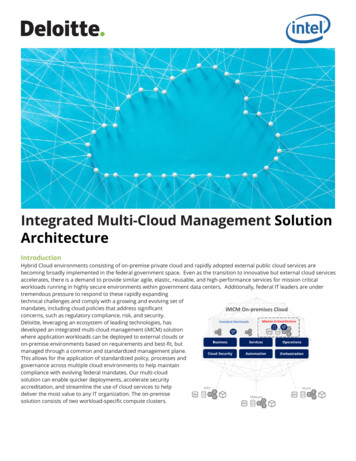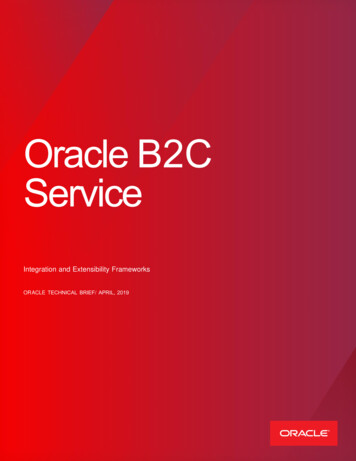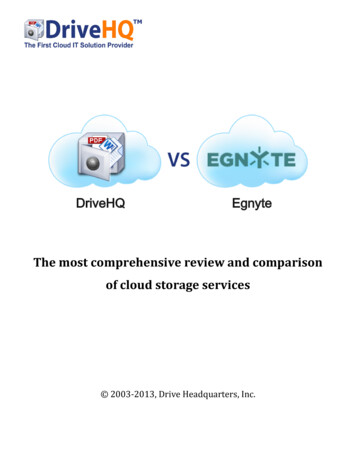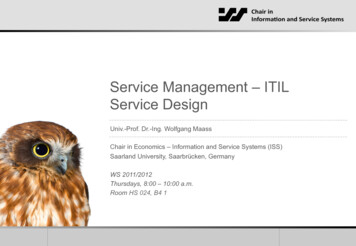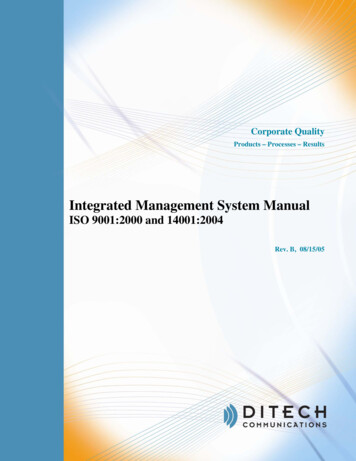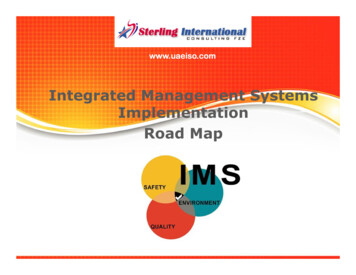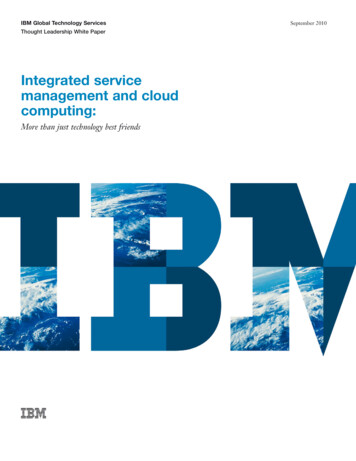
Transcription
IBM Global Technology ServicesThought Leadership White PaperIntegrated servicemanagement and cloudcomputing:More than just technology best friendsSeptember 2010
2Integrated service management and cloud computingContents2 Introduction3 Setting the stage: Service management is 4 Cloud computing is 5 Lessons learned: Service management is to cloud aselectricity is to computing10 ConclusionIntroduction Are you wondering about the role Integrated ServiceManagement plays in cloud computing?Are you wondering how all that hard work you did toimplement ITIL applies to a new cloud computingenvironment?Are you wondering what new requirements cloud computing will introduce for your existing service managementcapabilities?And while cloud computing may save you money, are youwondering where the integration necessary to connect andoperate efficiently will come from?While the business side and user community have longhad an appreciation of services-based thinking, many ITorganizations are just beginning to adopt the principles behindservice management and its benefits. Following the successesof process re-engineering, IT (and its customers) came tounderstand that they were providing and consuming services,not just providing access to technology. As a result, traditionalsystems management disciplines evolved, and there has beenmuch discussion and many publications clarifying the properrole of IT service management. IT and IT services are nowdescribed in a different way. The IT Infrastructure Library ,Version 3 (ITIL V3) defines service management as “a set ofspecialized organizational capabilities for providing value tocustomers in the form of (IT) services.”1 The consensus isthat excellent service management is essential to derive themaximum benefit from a firm’s investment in informationtechnology.More recently, cloud computing has become an increasinglypopular means of delivering valuable, IT-enabled businessservices. Customers and end users access the IT service catalog through self-service portals, using and paying for onlythose services they need, when and where they need them. Formany enterprises and their IT organizations, adopting a cloudmodel is one path to cost efficiency and effective IT-enabledbusiness. And vital to being able to deliver, or even access, acloud-based environment is Integrated Service Management.While most traditional IT service management disciplinesremain sound practices, a cloud-based service delivery modelemphasizes essential competencies in new ways. Cloud services may originate from a variety of sources and the CIO musttransparently integrate and manage these services to customersand end users. Integration is crucial to success in cloud environments because of the need to orchestrate the actions ofpartners, vendors and customers in keeping with the firm’sstrategic intent for IT. The requirements are clear: IntegratedService Management is more, not less, important in a cloudenvironment. In fact, it is indispensible.
IBM Global Technology ServicesThis paper defines key aspects of Integrated ServiceManagement and cloud computing and describes their symbiotic relationship. As tightly intertwined as are electricity andcomputing, Integrated Service Management and cloud computing are now a matched pair. We discuss lessons IBM haslearned on how to weave them together to achieve optimalbusiness results at the lowest level of risk.Setting the stage: Servicemanagement is.When examined at a greater level of detail than the ITIL V3definition, service management comprises the whole of thegovernance, processes, role and responsibility definitions, toolsfor automation, required information and best practices thatintegrate and operate available resources to produce valuedservices, and respond quickly to the needs of a business and itscustomers—for both legacy and cloud environments. Thescope of service management includes anticipating businessneeds, service portfolio management, service life cycle management, service operation and continuous improvement.Service management is about the collaboration that takes placeto create value between communities of customers and users,and communities of providers and suppliers. This means goingbeyond infrastructure management to provide business servicemanagement.The mission of Integrated Service Management has finallyreceived long overdue recognition as a critical success factor inenterprise information technology. Integrated ServiceManagement enables organizations to deliver innovative business services by providing higher levels of visibility, controland automation that extend beyond traditional management ofIT service delivery and into business service delivery.3Integrated Service Management extends the traditional notionof an IT infrastructure to one that encompasses many intelligent devices such as smart electric meters and traffic controllers into high automated networks. These devices worktogether to generate technology-enabled business services.Integrated Service Management recognizes IT managementprocesses as a specialized form of integrated business processesrather than something outside “the rest of the business”;therefore, the same techniques and value provided throughintegrated applications to business processes apply equally wellto IT management processes.Tailored for specific industry requirements and business situations, Integrated Service Management is the latest evolutionary step in IT management, enabling organizations to: Blend the processes, organization and technology necessaryto support current and future IT-enabled businessesPromote the widespread use of defined policies in support offast and accurate responsivenessProvide the foundation for analysis of critical, real-timeinformation, enabling the quick decision making that thedynamic global marketplace demandsThe result is that Integrated Service Management links theentire business, including IT management, directly to thetechnology resources it needs.The Service Integrator roleIntegrated Service Management spans the business, IT andpartners. The CIO sponsors effectiveness and innovation initiatives for all technology elements of the business infrastructure, not just the traditional catalog of IT-enabled businessservices. The Service Integrator role is formally chartered to
4Integrated service management and cloud computingCloud are-as-a-ServiceAPICloudServicesConsumerEnd s-a-Service(Virtualized) Infrastructure – Server, Storage, Network, FacilitiesInfrastructure for hosting Cloud Services and Common Cloud Management PlatformPartner CloudsCommon Cloud Management PlatformCustomer MgmtOffering MgmtBSSOrder MgmtPricing & RatingSubscriber MgmtEntitlement MgmtBillingPeering & SettlementService OfferingCatalogOpportunity to OrderMetering, Analytics & ReportingService Delivery CatalogService Automation ManagementService TemplatesOSSOperationalSupportServicesService RequestManagementProvisioningMonitoring & EventManagementImage LifecycleChange & ConfigurationManagementManagementIT Service LevelIncident & ProblemManagementManagementCapacity & PerformanceIT Asset &ManagementLicense ManagementService Development PortalInvoiceGeneral accountingContract &Agreement MgmtAPIConsumerIn-house ITBusinessSupportServicesService Delivery PortalConsumerBusinessManagerCloud computing is Cloud computing is emerging as an important model fordelivering valuable, IT-enabled business services. It is a modelthat enables and supports both a particular style of businessmodel and a specific kind of user experience. Cloud computing applications, data and IT resources are presented to usersthrough self-service portals. Requested services are deliveredtransparently over the network. “Cloud,” as it is commonlycalled, offers economies of scale and flexible sourcing optionsto the business. Another part of this emerging construct is aninfrastructure management methodology for managing largenumbers of highly virtualized resources. These virtualizedresources can reside in multiple locations, but still perform asa single large resource to deliver services. Figure 1 illustratesthe relationships between virtualized resources and varioustypes of services. Basic cloud services are organized into fourcategories. Within the common cloud management platform,business support services (BSS) enable the identification, ordermanagement, accounting and subscriber management functions related to consumers and end users. Operational supportservices (OSS) support successful cloud service delivery andoperations.Cloud Service ProviderCloud ServiceConsumerUserInterfacecarry out governance, ensure well-managed relationships andretain accountability for end-to-end service performance. TheService Integrator must also facilitate organizational changethat results in staff becoming more productive faster and aculture of cooperation, all as part of managing a complex multisourced environment. The individual or team performingthis role must be responsive, unhampered by organizationalboundaries, and decisive.Service DefinitionToolsImage CreationToolsVirtualization vice Transition ManagerService Business ManagerService Provider PortalSecurity & ResiliencyService Operations ManagerService Security ManagerFigure 1. IBM Cloud Computing Reference ArchitectureThe IBM Cloud Computing Reference Architecture highlights how service management functions and services can bestructured in the context of a “cloud,” linking the business tothe technology resources it needs as Integrated ServiceManagement.What are cloud delivery models?Cloud delivery models represent different ways to obtain andorganize resources for the delivery of services. Options includeclouds that are internal to the enterprise (private), external
IBM Global Technology Services(public) and a combination of both (hybrid). These three commonly recognized types of cloud environments are defined bythe following characteristics: Private: Activities and functions are provided “as a service,”via a company’s intranet. A private cloud, also called an“internal cloud,” is built by an organization from resourcesit owns for its customers and its internal users. All servicesare delivered within the organization’s firewall (versus theInternet). The private cloud owner does not share resourceswith any other company, so multitenancy (i.e. a singleinstance being shared across more than one enterprise) isnot an issue. The focus is on operational excellence andmaximization of resource utilization.Public cloud: IT activities and functions are provided “as aservice” via the Internet from external suppliers, usingresources not owned by the consumer. Public clouds, alsocalled “external or open clouds,” allow access to technologyenabled services without knowledge of, expertise with, orcontrol over the technology infrastructure that supportsthem. In this model, the CIO and IT must address theService Integrator role.Hybrid cloud: External and internal service deliverymethods are seamlessly integrated. Rules and policies areestablished by the partnering organizations based on factorssuch as security needs, criticality and underlying architectureso that activities and tasks are allocated to traditional IT,external or internal clouds, as appropriate. As in publiccloud, the Service Integrator role is essential for beneficialcollaboration between all parties involved in the cloud.Organizations around the globe are assessing the applicabilityof cloud computing to their infrastructures. They recognize itspotential to reduce costs through standardization and5economies of scale, as well as to speed time to value. Servicecapacity can be expanded or contracted as demand changes;the use of well-designed and managed clouds can creategreater overall elasticity. Some organizations also expect toleverage clouds for improved staff efficiency and optimizationof IT resources, leading to higher returns on IT investments.Early cloud computing adopters have already gained valuableinsights.It is essential to balance Integrated Service Management capabilities and cloud options in a way that can support optimalbusiness results at the lowest level of risk. The next section ofthis paper discusses the lessons learned in achieving both balance and results.Lessons learned: Service management isto cloud as electricity is to computingThe CIO of the firm providing a business service retainsaccountability for the quality of all the IT services delivered.CIOs and their staff must be innovative and flexible in howthey adapt service management best practices to respond tocontinually changing business needs. Adaptability is importantbecause the characteristics of service management can changebased on the environment and the service solution—whetherit is a legacy system, cloud based or a combination of the two.Over the past three decades, IBM has learned valuable lessonsthrough its own research and experiences in service management and, more recently, cloud computing. With nearly 8 million square feet of raised floor under management supporting400,000 internal users and a large base of outsourcing andmanaged business process customers, IBM’s IT organization is
6Integrated service management and cloud computingconstantly seeking ways to become more effective and efficient. These lessons are then used to assist our clients inimproving their IT operations. Through this experience, wehave reached the following conclusions.“IT infrastructure” extends well beyond the equipment owned by anenterprise.An IT infrastructure is an expansive collection of networkedservices from many potential sources—services that collectively enable and support vital business operations.Historically, IT focused on application development and systems management, yielding stable business-as-usual computeroperations. In reality, very little is business-as-usual now. Therapid and continuously changing expectations of IT dictatethat governance predicated on sound service management isessential to reliable and consistent service delivery. IBM hashelped the evolution to Integrated Service Management bydeveloping best practices that leverage the integrationand optimization of people, processes, technologies andinformation—all of which must collaborate to achieve cost andquality objectives in the form of services that support the business. With this optimized collaboration, IT is positioned toexpand its role in pursuit of additional revenue-generatingservices.Standardization is an important and pervasive requirement.Technical standards have existed for decades, which is whatallows interoperable systems. But standardization is increasingly extending into the software stack to encompass businessprocesses. Models, reference architectures and a common language for technical terms promote increasing standardization,and with it, agility—that is, knowing where and how to makechanges, and what the effects will be.A service architecture that maps each business process to its enablingservices is required to understand all of the relationships and dependencies, as well as to manage change.In addition to simple process-to-service correlation, the mapwill indicate whether the service is an input or output and outline typical demand cycles as it is used. The understandingcaptured in a service architecture is necessary to design wellbounded applications. Clearly specified application boundariesare a key requirement for workloads being considered formigration to a cloud environment.Clear policies and standards are important.For example, from a service catalog perspective, when a service is planned for delivery through a public or hybrid cloud,IT should establish a policy relative to the level of informationcustomers or users will have about external providers and theirroles. A complete and clear set of unambiguous policy statements is required, so they can then be automated to permitthe dynamic changes necessary for cloud infrastructures.Cloud computing readily supports both application development andoperations.Cloud computing offers great potential, but that potential isrealized only by a combination of new technologies, reuse ofaccurate business models and advanced Integrated ServiceManagement capabilities. Innovation and efficiency dependupon the proper mix of all three. Service management enablescloud cost savings and accelerates the availability of new services at nearly every level of the value chain. The savings fromcloud may also strengthen the business case for improvementsin your service management environment.
IBM Global Technology ServicesSeveral service management objectives and results are vital to alltypes of cloud delivery models.Whether the cloud delivery model is private, public or hybrid,the following service management objectives are critical: Standard servicesClear, complete description of services, including definitionof service levelsPricing quoted per use or by consumptionHighly available networks and connectivity, supported byboth business support and operational support services andautomationEasy access, self-service enabling portals for service selectionand requestRapid fulfillment and rapid decommissioning, supportedwith end-to-end automationService guaranteesSecure computing and storageThese objectives all require a high level of service management maturity to attain. We refer to that high level asIntegrated Service Management. Specifically, it includes goalsand objectives, process characteristics, interfaces, measures,organizational structures, roles and responsibilities, supportingautomation or integration and continuous improvementcomponents of service management. These should all besynchronized to work effectively and efficiently with businessprocesses to provide critical IT-enabled business services. YourIT function needs to perform the same service managementactivities it has been doing, and do them very well. We recommend that key service management processes be at a high levelof maturity on the IBM Service Management Maturity Scale.However, IBM studies to date have indicated that many companies have significant gaps in service management capabilitiesand infrastructure readiness for cloud computing.27The CIO and IT organizations must commit to full participationand leadership in the governance, introduction and piloting of newcloud or service management initiatives for enterprise business use.Key issues and considerations for service management include: Service portfolio management and service life cyclesComplianceRisk mitigationFinancial practices and cost benefit analysisFaster time to valueImproved qualityAgility and responsiveness to competitive threatsSecurityAbility to rapidly scale up and downCustomer Satisfaction ManagementFor a CIO, understanding which service management capabilitiesare required and how they will be achieved may be as important asunderstanding the services themselves.If the underpinning capability is lacking or unreliable, thenthe situation is likely to have a negative impact on more thanone service and on overall business objectives. Consider, forexample: Network availability, connectivity and reliability are essential. No connectivity or unreliable connections means noservice.Service catalog management and operations are essential. Ifthe catalog is not available or corrupted, then no servicescan be ordered.Event, incident and problem management must be orientedto, and tuned for, highly available networks, service catalogs,end-to-end service monitoring and rapid service restoration,and encompass all intelligent components that contribute tothe service. These all become more complex in a virtualizedenvironment.
8 Integrated service management and cloud computingSelf-service and highly automated provisioning of servicerequests is a foundational capability in service managementfor clou
cloud-based environment is Integrated Service Management. While most traditional IT service management disciplines remain sound practices, a cloud-based service delivery model emphasizes essential competencies in new ways. Cloud serv-ices may originate from a File Size: 644KB

